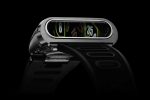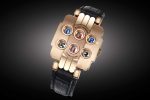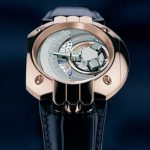A. Lange & Söhne
Hands Free
“Wandering hours” watches usually indicate the hour via digits in an aperture, while the minutes are shown through the movement of the aperture either around the outside of the dial or across a calibrated scale. It could be argued that this is not a true digital as the hour digit ostensibly acts as a hand but the main presentation of the time is numerical and they do differ dramatically from the conventional analogue display.
The Earliest Times
Of the two systems, the first to appear was the wandering hours. This mechanism was used on a night clock designed for Pope Alexander XII in 1656 by the Campani brothers. The insomniac pope requested a silent escapement and the ability to read the time in the dark, so the hour aperture acted as a window allowing the light from an oil lamp to illuminate the numerals. After 1680 the development of the balance spring allowed this concept to translate to pocket watches and it was popular for 30-40 years before being supplanted by the classic two-hand dial. In the 1800s Perrin Frères, Breguet and others revived the style, although the simpler neo-classical form did not really catch on outside of France.
Pure digital watches had a slower start. The first recorded example was a watch made for King Louis-Philippe d’Orléans of France in 1830 by Blondeau. Mass production came half-a-century later with a movement patented by Joseph Pallweber and licensed to companies such as Cortebert and IWC. This was an advanced movement in that it had both jump-hour and jump-minutes with a double-digit minutes display.
Wrist Numbers
The development of the wrist digital seems to have begun in 1921 with Audemars Piguet’s jump-hour continuous minutes HPVM10 calibre. This was offered in either pocket or wristwatch form, but it was the wristwatch that truly embodied the times. The Art Deco movement and bold geometric shapes fully embraced the times and this elegant piece would still appear contemporary today.
The 1920s saw a number of manufacturers embrace the digital form, often using the AS349 jump-hour movement. This round movement was conventional in many ways but a few minor adjustments dial-side produced a simple and robust jump-hour system that was used in some cheaper, un-named watches but also by the likes of Rolex. As the Art Deco period progressed, rectangular jump-hour watches appeared from manufacturers ranging from Certina to Cartier.
During the Second World War, form had to follow function and style surrendered to practicality. The digital watch had never established itself as anything more than a style statement and so the analogue hegemony was re-established. In the post-war years, confidence and optimism returned along with a passion for all things futuristic. This was precisely the environment that made digitals popular in the 1920s and so the trend was repeated. Designs from the American brand Elgin were typical of the 1950s, with the Chevron, the Golf Ball and the Elvis exemplifying the bold brash styling that extended through automobile production and architecture. Eye-catching though the cases were, the movements had not progressed significantly compared to the AS movements of the 1920s with a jump-hour wheel and continuous minutes and seconds offered in the same configuration.
The Fight Against Quartz
If the 1950s were about futurism and a love of technology, the early-1970s were all about competing with that technology. The launch of the first quartz watch by Seiko in 1969 was quickly followed by Pulsar’s LED digital in 1972. These timepieces were expensive status symbols, often cased in gold, so it is no surprise that mechanical competition went for the lower end of the market. Mechanical digitals were produced by a wide number of manufacturers predominantly at the entry level. Brand names, with a few exceptions, read like a roll call of those who did not survive the quartz crisis. A few bigger brands produced their version of digitals, notably Tissot with its Newtimer featuring the in-house 24- jewel calibre 2481 – a very high level of movement compared to most in the market at the time.
Special mention has to be made of two unusual digital watches from the 1970s. The first is the Time Recorder, which took a very standard Baumgartner movement used by the likes of Buler and Sorna and, with a little dial-side cunning, created a watch where, not only do the hours jump, but the tens of minutes jump too, leaving only the units of seconds in continuous motion. This was a rare step forward and an achievement that was not bettered for more than 30 years.
Digital As Art
As watchmaking began its renaissance at the beginning of the 1990s it was the wandering hours watch that led the way. In 1991 Audemars Piguet launched the Star Wheel, a wandering hours watch in the style of the original 17th-century clock. AP took the audacious step of removing the dial cover, allowing the slow revolving dance of the sapphire discs to be seen. Since the original Star Wheel was produced the concept has been revisited a number of times, most recently in the Millenary collection.
At the other end of the 1990s, Urwerk took the same concept in a completely different direction. If the Star Wheel was traditional, Urwerk’s 101 – produced in 1997 – was space age. The brand has taken the wandering hours watch on an incredible journey of innovation and transformation. The 101 was simple, bordering on the stark, whereas the 103 and later 103.3 progressively revealed more of the time display mechanism and so added to the intrigue of the watches. The greatest change in terms of the time display came with the transition from the rotating discs, not so far removed from the original Campani clock, to the numbered cubes on the 201 from 2008 that turn in a vertical rather than horizontal plane. This gives the progress of time a high-tech, robotic feel.
In subsequent years, watch aficionados have been treated to ever more elaborate solutions to the digital challenge. Watchmaking at the highest level is no longer bound by considerations of practicality or affordability, this is mechanical artistry where imagination – assisted by the latest materials, CNC and CAD – can produce the impossible.
In 2009 A. Lange & Söhne finally improved on the 1970s Time Recorder by offering us jumping hours and jumping minutes in their Zeitwerk. The brand was the first to go into production, however, back in 2003 as part of the Harry Winston Opus Collection, Vianney Halter had proposed a watch with not only jumping date, hours and minutes but also a countdown of the last four seconds of each minute. The sheer complexity of such a watch caused a seven-year delay before the prototype could be turned into a viable watch for series production, but the achievement given the torque required by the movement is astonishing.
The following year was a case of déjà vu as MB&F created an Amida Digitrend for the 21st century. Taking inspiration from the cheap and cheerful 1970s sideview watch, the HM5 reinvented it with all the refinement that modern haute horlogerie could provide. The movement, crystal and case construction were all improved and conceptually expanded but at the core is the brilliant idea of the reverse printed, 90° reflected numerals.
Magic Numbers
The pressure of space dictates that there are numerous contemporary mechanical digitals that cannot be covered here, both pure digital displays and all manner of alternative display methods form sliding markers against digital scales to variants on the rotating numbered disc theme. The freedom of expression that watchmakers now have means that the digital display is just another way to surprise and delight the watch wearer.
The human brain is an analogue device. It responds fastest to patterns, symbols and spatial relationships. This is why an analogue watch dial can be reduced to just two hands and a noon reference point and still work well. It takes longer to read a digital dial, process the information and register what we are being told, which may explain why, after so many centuries, analogue time display is still so popular. That said, analogue displays, with a need to read off the tip of a hand against a finely calibrated scale, are not good for precise readings.
While jumping dates and jumping hours are common, move to minutes or even seconds and the problems multiply proportionally. A jump seconds would require a spring to be primed and released 86,400 times a day – possible if you are moving a seconds hand in a dead-beat escapement but so much harder is you are trying to move numbered discs. The ingenuity and determination to solve such problems is the reason that these watches and their makers are such objects of admiration.
The Harry Winston Opus Collection
In 2001 Harry Winston’s Watch Division, under the leadership of Maximilian Büsser, began a series of collaborations with leading independent watchmakers that have created some of the most extraordinary watches of recent years. As watches that pushed the limits of creativity and technology, it is no surprise that a significant number of them featured digital displays.
Opus 3 by Vianney Halter was a steampunk design featuring six portholes, each with a jumping display. This watch shows the date, the hours and the minutes with a four-second countdown to the change of minutes.
Opus 5 by Felix Baumgartner shares many of the design cues with the wandering hours Urwerk 201 – unsurprisingly as he is the co-founder of the brand, along with Martin Frei.
Opus 8 by Frédéric Garinaud and CSH is most strongly reminiscent of a 1970s Pulsar LED digital watch. The “pin-board” display shows the time on demand by pressing mobile segments upwards to create the numerals.
Opus Eleven by Denis Giguet shows its minutes display as a pair of rotating discs, jumping for the tens and continuously running for the units. The hours display is not so much jumping as exploding. As 60 minutes expires, the digits scatter into fragments before reforming as the new number a moment later













